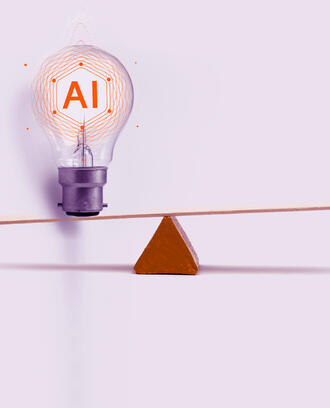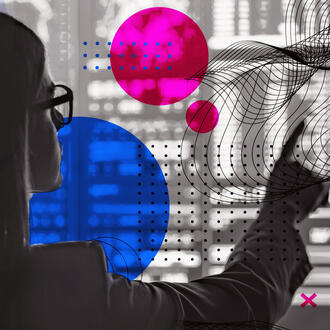These human capabilities complement AI’s shortcomings
By
What impact will AI and emerging technologies have on the U.S. labor force? Since the arrival of ChatGPT a little less than three years ago, such debates have typically fallen into one of two categories: ways AI can augment the workforce and ways AI-driven automation will disrupt the workforce.
A new paper from MIT Sloan postdoctoral associate Isabella Loaiza and professor takes a different approach, asking ,“What human capabilities complement AI’s shortcomings?”
The approach shifts the discussion from disruption and labor substitution toward human abilities. “In the future-of-work field, the focus is often on machines and not humans,” Loaiza said. “We wanted to focus on what humans can do. We don’t want to instill fear in people’s hearts. We wanted to show how AI is going to complement workers.”
To answer their question, the researchers developed a framework of human-intensive capabilities that gave rise to three key metrics:
- A risk-of-substitution score
- A potential-for-augmentation score
- A score that indicates whether a task relies on certain human capabilities that AI lacks, among them ethics, creativity, and emotional intelligence.
The pair then applied each of these metrics to all U.S. tasks and occupations identified by O*NET, a U.S. Bureau of Labor Statistics database of occupational information that defines 19,000 tasks across approximately 950 types of jobs.
Their conclusion? Work that is dependent on human characteristics such as empathy, judgment, and hope is less likely to be replaced by machines.
AI is impacting higher-skilled work
Technological advances have always sparked worker concerns, but advances in mechanization, automation, and digitalization generally improved the quality of people’s jobs over time. This may not be the immediate case with artificial intelligence.
Related Articles
“AI feels different because it threatens to replace capabilities deeply connected to our cognitive ability,” Loaiza and Rigobon write, noting that AI is capable of brainstorming, content creation, and problem-solving.
“AI has been moving faster, and the effects we see in the labor force are different,” Loaiza said. “Previous waves of technology tended to negatively impact lower-skilled workers, while AI is impacting workers regardless of their education attainment.”
That said, AI has its limitations. It cannot make inferences from small datasets or extrapolate far beyond a training dataset. Problems with more than two viable solutions, and decisions based on shared experiences, pose a challenge for AI as well.
And, critically, AI struggles with subjective beliefs — which the researchers characterize as decisions based on a range of outcomes that differ from what the data suggest. “Some of the most transformative decisions in human history have been driven by beliefs that defied the status quo, even when prevailing data appeared to support it,” they write, citing women’s suffrage and the civil rights movement as cases where conviction took precedent over the status quo.
“[Humans sometimes] make decisions not because the data tells us it’s possible but because, out of principle, it should be done,” Loaiza said.
Humans can still do things AI cannot
To begin their study, Loaiza and Rigobon outlined five groups of human capabilities, represented by the acronym EPOCH.
- Empathy and emotional intelligence. AI may be able to detect emotions, but humans can create a meaningful connection and share what the person is experiencing. Occupations such as social work and education illustrate this well.
- Presence, networking, and connectedness. Roles in nursing and journalism reflect the importance of physical presence in building connections, fostering innovation, and collaborating with colleagues.
- Opinion, judgment, and ethics. Humans can navigate open-ended systems, such as the legal profession and the science industry, whereas AI struggles to grasp concepts like accountability and responsibility.
- Creativity and imagination. Humor, improvisation, and “the visualization of possibilities beyond reality,” as the researchers put it, remain uniquely human abilities. They are especially valuable in design work and scientific work.
- Hope, vision, and leadership. Grit, perseverance, and initiative further embody the human spirit. This means taking on a challenge despite long odds of success, such as starting a new company.
Armed with their framework, Loaiza and Rigobon used the O*NET data to study its nearly 19,000 work tasks in the context of automation and augmentation, and their relationship to human capabilities.
These so-called task statements are descriptive but specific to each occupation. That means that there is little overlap between different occupations’ task descriptions, which makes it difficult to identify similar tasks distributed across different roles.
To overcome that limitation, Loaiza and Rigobon grouped the tasks into 750 clusters. One cluster, for example, consists of similar tasks associated with building sales websites in different occupations. Another comprises tasks associated with design review in fields as diverse as game design, engraving, and digital imaging.
The researchers then assigned each cluster of tasks three scores — the risk-of-automation score, the potential-for-augmentation score, and the EPOCH score, which indicates whether a task has related EPOCH capabilities that may protect that task against automation. From there, they compared those results against an aggregate change of employment in the U.S. labor force from 2016 to 2024.
The researchers found that tasks with a high risk of automation and/or augmentation came with a corresponding high risk of job loss. The automation-related findings reflect AI replacing human labor. As for augmentation, the decline in employment stems from an increase in productivity, meaning a firm can produce more without hiring additional workers. Augmentation isn’t necessarily partial automation, Loaiza noted; it simply means that workers can either complete tasks more quickly than before or perform tasks they couldn’t do before.

Leading the AI-Driven Organization
In person at MIT Sloan
Register Now
Human capabilities make a job more resilient
In contrast, all EPOCH capability groups were associated with employment growth, with the largest impact coming from the hope human capability and the second-largest from the opinion capability. These results, the researchers write, show a “shift towards a more human-intensive work not only in terms of the tasks performed in each occupation but also by the number of people employed in more human-intensive occupations.”
The positive impact of human capabilities was a pleasant surprise to Loaiza, but not necessarily an unexpected one. “Especially in developed economies, there are a lot of top-level managers in decision-making roles” who do work associated with high EPOCH scores, she said. “There’s a lot of value in human workers.”
For Loaiza, the findings reinforce the notion that AI strategy must emphasize augmenting workers rather than replacing them. It also gives enterprise leaders a road map for upskilling workers — with particular attention paid to “the fundamental qualities of human nature,” which are easy to overlook when training workers for a future driven by the use of AI.
“In a lot of fields workers can’t be fully replaced,” Loaiza said. “If you’re aiming for disruptive innovation or truly transformative business, humans have a huge role to play.”
Read next: When humans and AI work best together — and when each is better alone




